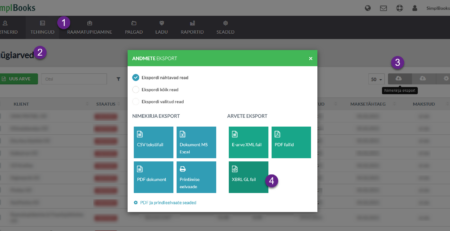E-invoices – frequently asked questions and answers
E-invoices – frequently asked questions and answers
In the summer of 2025, an important change in Estonian accounting law came into effect: all companies registered in the Business Register as e-invoice recipients have the right to request e-invoices from their partners. If a client requests it, the seller is obliged to issue the invoice in e-invoice format, rather than as a PDF file or on paper.
This means that the e-invoice requirement no longer applies only to public institutions but also to private companies that have decided to switch to e-invoices. If your company operates in the B2B sector, it is likely that sooner or later you will also need to deal with sending e-invoices.
But what exactly is an e-invoice? Is a PDF no longer acceptable? How difficult is it to send e-invoices?
In this blog post, you will find answers to the most common questions regarding e-invoices.
1. What exactly is an e-invoice?
An e-invoice is a machine-readable document that moves directly from one accounting software to another. The invoice issuer sends the invoice from their software, and it arrives automatically in the client’s system. There is no need to manually enter data or send the invoice by email.
This makes the entire process much smoother: fewer errors, less manual work, and more time for important tasks.
2. Do all companies now have to send e-invoices?
Not all companies, but you must have the ability to send them if your client requests it.
If your client is registered in the Business Register as an e-invoice recipient and requests an e-invoice, you are obliged to provide it.
3. How do I know if my client expects an e-invoice?
You can check this in the Business Register. If a company is listed as an e-invoice recipient, you must send them e-invoices.
If you use SimplBooks software, you don’t need to remember this yourself – the system checks the information automatically:
-
If the client accepts e-invoices, SimplBooks will offer e-invoice sending by default.
-
If not, the system offers the invoice as a PDF.
Additionally, SimplBooks provides a clear notification when sending an invoice if the client does not accept e-invoices. This helps avoid confusion and rejected invoices.
4. What happens if my client requests an e-invoice but I still send a PDF?
If a company is registered as an e-invoice recipient in the Business Register, it has the legal right to request an e-invoice. If you send a PDF invoice, you should contact the client to check whether it is acceptable or if the invoice needs to be resent as an e-invoice.
Clients may exceptionally accept a PDF invoice if agreed in advance. However, they have the right to refuse, in which case you must issue the invoice in the correct format – as an e-invoice.
5. Is sending e-invoices difficult or expensive?
Sending e-invoices is not difficult. Most accounting software allows sending e-invoices at reasonable costs, which is affordable even for micro-enterprises. For example, in SimplBooks, sending e-invoices is free in all packages!
The process itself is very simple:
-
Log in to your SimplBooks account
-
Create and save a sales invoice
-
Select “Send Invoice” from the actions menu, where you can choose to send it as an e-invoice
It’s that simple and fast! There’s no need to create PDF files or send them via email – the software does the work for you.
6. Why should I use e-invoices? What are the benefits?
E-invoices make everyday invoicing much smoother and smarter for your business.
Here are some key advantages:
-
Time-saving and efficiency: The entire invoice process becomes faster – e-invoices go directly to the client’s system, eliminating the need for manual entry or retyping. Less routine work, more time for important tasks.
-
Fewer errors: Automatic data transfer significantly reduces the risk of human errors. Numbers are entered correctly, and information is not lost.
-
Faster payments: Since e-invoices arrive quickly and accurately, clients can process them faster. Many businesses have noticed that e-invoices help reduce overdue payments.
-
Security: Unlike PDF invoices sent by email, e-invoices are transmitted securely and encrypted, reducing the risk of invoice fraud.
-
Eco-friendliness: Using e-invoices means less paper, printing, and manual work, reducing environmental impact and supporting greener business processes. Compared to paper invoices, the environmental impact is reduced by up to 89%. Beyond sustainability, it also makes everyday business operations smoother and more efficient.
In summary, e-invoices make accounting not only easier but also safer, more accurate, and environmentally friendly. Most importantly, they are suitable even for small businesses and do not require large investments.
You can find more information about e-invoices in our other blog posts:
Sending and receiving e-invoices with SimplBooks
E-invoicing – what does an entrepreneur need to know?




Leave a Reply